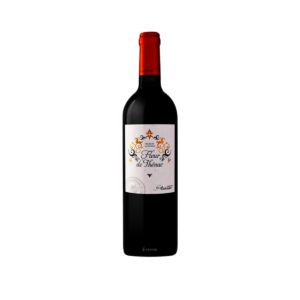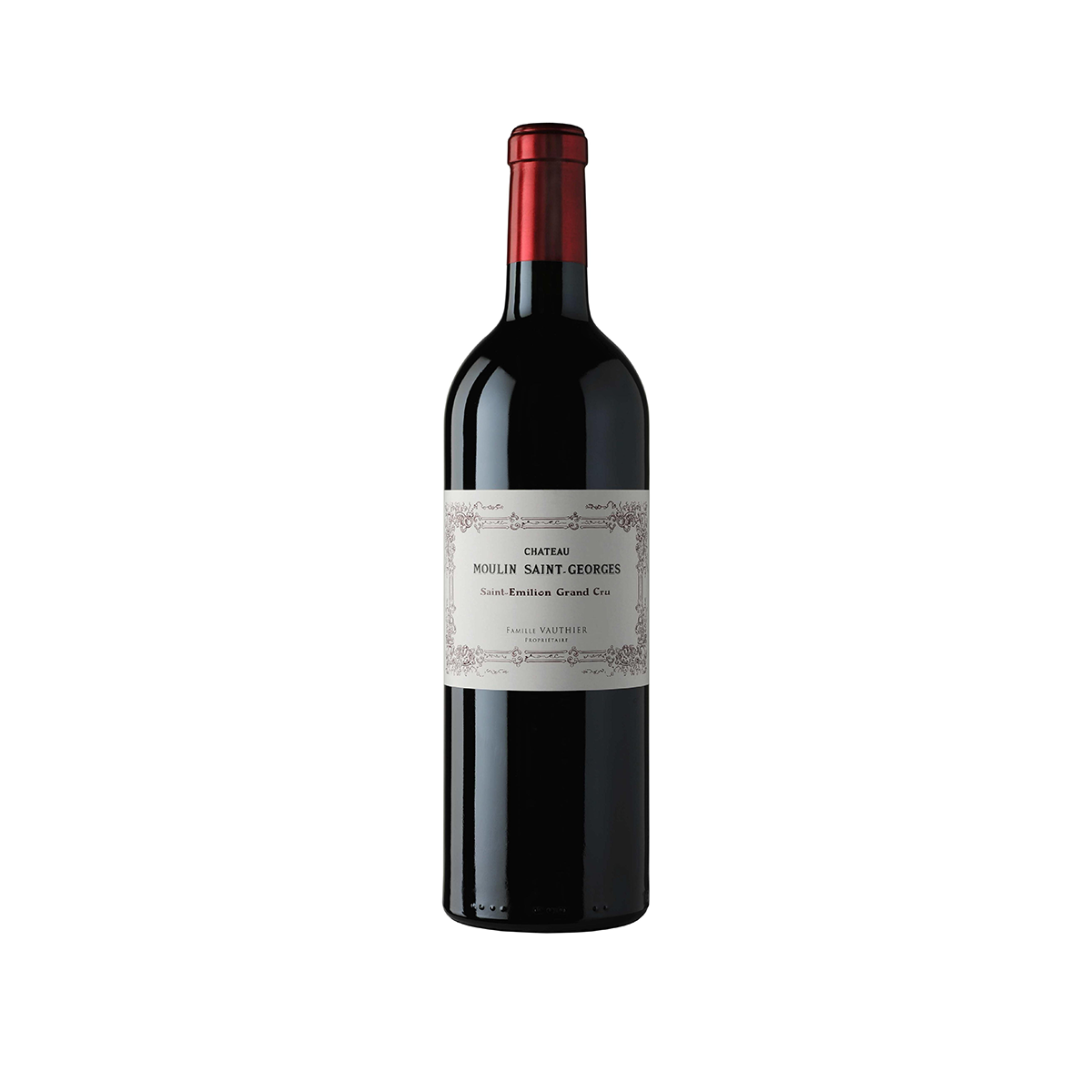View cart “Jean-Philippe Janoueix, Château Croix Mouton, Bordeaux Superieur, 2017” has been added to your cart.
Famille Vauthier, Château Moulin Saint-Georges, Saint-Emilion Grand Cru, 2017
Datasheet
| Country |
France |
|---|---|
| Region |
Bordeaux |
| Origin | |
| Winery |
Château Moulin Saint-Georges |
| Volume |
0,75 |
| Alcohol |
13% |
| Grape |
80% Merlot and 20% Cabernet Franc |
| Technology |
Red – Savory and Classic |
| Aroma |
Nice ruby red on the eyes, vanilla and cherry on the nose |
| Taste |
Bright and fruity, this wine has soft tannins and attractive, juicy acidity. The wine's structure and fruitiness suggests that it will age quickly |
| Vintage Year |
2017 |
| Sugar |
dry |
| Quantity btls |
Description
Situated on seven hectares in a plot which borders the south entrance of St Emilion, the 2017 is a blend of 80 percent Merlot and 20 percent Cabernet Franc. It has attractive aromatics of red fruit, blueberry, crème de cassis and a suave, bright texture. A long, persistent finish.
Customer reviews
Related products
Château Carbonnieux Blanc, Pessac-Leognan, 2012
213,00 ₾
Classified White Wine. Cru Classe de Graves in 1959.
"Fresh, lively lemon peel, grapefruit, vanilla bean and green apple on the nose is a treat, but it gets even better with the sweet, slightly honeyed, fresh citrus fruits with just a hint of vanilla in the zesty finish. The wine was produced from a blend of 70% Sauvignon Blanc and 30% Semillon. 91 Points" - 91/100, Jeff Leve, The Wine Cellar Insider
Château Carbonnieux white is a legendary wine. It is said that in the 18th century it was introduced to the Sultan of Constantinople’s palace because of its clarity and was called “mineral water from Carbonnieux”, thus defying the Islamic law.
The clay–limestone of Garonne gravel found in the Pessac-Léognan Appellation certainly produces the best dry white wines in the Bordeaux region. When young, Carbonnieux white wines are delightfully refreshing and pure with a fruity, floral intensity. When mature they develop hints of dried and candied fruits giving scope for a large range of gastronomic pairings. The batches which will form part of this “cru classé” will be blended so as to induce an excellent complicity between the grape varieties. The chosen Semillon grapes will add structure to the liveliness of the Sauvignon grapes by giving them roundness and volume on the palate.
Serving temperature : 12 – 14°C
Cellaring advice : 4 – 8 years
Wine and food pairing : raw or cooked fish, seafood, foie gras, white meat, exotic dishes, cheese, fruit desserts…
We advise storing these wines in a cool dark place at a consistent temperature and humidity level.
In spite of the care taken in the winemaking process, white wines remain more fragile than red wines.
Professional Ratings
- 94Wine Enthusiast
This is pure fruitiness but with a tense, tight structure underneath.The fresh exterior is all citrus fruits and acidity, while behind lies a texture that demands aging. It’s impressive, rich and worth waiting for. Drink from 2018.
- 93Wine Spectator
Solidly built, with lemon pulp and grapefruit rind notes framing a rich core of creamed yellow apple and white peach. Nice minerality drives the finish. Barrel Sample: 90-93 Points
- 92Robert Parker's Wine Advocate
Another full-throttle 2012 dry white, this 2012 offers lots of honeysuckle notes as well as a full-bodied mouthfeel and beautiful purity, elegance and length. Lemon zest, grapefruit and subtle wood characteristics are found in both the aromatic and flavor profiles. Barrel Sample: 90-92 Points
Château de Fieuzal, L’Abeille de Fieuzal Rouge, Bordeaux, 2019
133,00 ₾
Over the years, L’Abeille has developed a strong identity of its own. Crafted with the same careful attention as Château de Fieuzal, it is conceived for light-hearted, easy-going enjoyment. Its fruit stems from the same vines as the first wine, grown with the same degree of care and preserving Fieuzal’s unique combination of freshness and finesse. L’Abeille red is majority Merlot, therefore delicately smooth whilst being juicy, fruity, and full of character.
Chateau du Retout, Haut-Medoc, 2018
93,00 ₾
68.5% Cabernet Sauvignon, 24.5% Merlot and 7% Petit Verdot planted here, the vines grow on a gravel ridge, close to Lamarque, where one can catch a ferry across the Gironde estuary to Blaye. Great care is taken in the vineyards, with ploughing between the rows and only natural fertiliser made from horse manure and organic waste from the vines used. This 2018 is a truly appetizing bottle, with aromas of ripe damson and plum, very pure. There is a lovely fleshy texture, with fine tannins and super length to finish.
Château Lilian Ladouys, Saint-Estephe, 2018
162,00 ₾
When tasted, Lilian Ladouys always reveals a rich and crisp structure with ripe tannins and refined oak which melts into an explosion of fruit. It has the opulence and length of a Saint-Estèphe fine wine. Thanks to the appellation’s limestone-clay subsoils, its power is balanced out by a wonderful sensation of freshness.
Our top wine is matured for an average of 14 months in our superb barrel store (40-60% new oak depending on the vintage). Cabernet Sauvignon and Merlot make up the majority of the blend, with the proportions varying from one year to the next. They are supplemented by Petit Verdot and Cabernet Franc. The estate’s wines go into gravity-fed vats and undergo vinification with a partially gravity-based system, which is more sensitive to the integrity and subtleties of the grapes and the wine.
EPC, BLANC DE BLANCS BRUT, Coteaux du Sézannais
230,00 ₾
This refreshing cuvée from the Côteaux du Sézannais region is reminiscent of delicate exotic fruits. Its promises? Gourmandise, dynamism, and a table of guests that will be begging for a second glass.
Champagne Blanc de Blancs Brut will be amazing paired with a veal onglet in a hazelnut crust, served alongside a risotto with oyster mushrooms and Comté cheese.
The Coteaux du Sezannais vineyard is a magnificent terroir spread over 12 communes and 1477 ha. Predominantly chalky soil creates an ideal environment for Chardonnay, while the presence of clay and sandy soils contributes to producing wines that are complex, ripe, and fruitier compared to those from the northern region.








